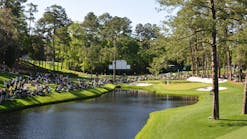The public school district in Hingham, Mass., comprises six schools, including Hingham High School. The high school aims to graduate students with the academic, civic, social and personal skills necessary to become productive, responsible members of society. With the support and involvement of the community, Hingham High School engages students in a challenging, well-balanced educational program complemented by cocurricular activities.
As part of the cocurricular activity offerings, the school touts a number of athletic teams, including football, boys’ and girls’ soccer, track and field, cross country, softball and baseball. In an effort to upgrade its athletic facilities, Hingham High School reconstructed and replaced its traditional grass fields with synthetic turf fields. The permitting process for the renovation took place in late 2012 and early 2013, and the actual construction ran from June to August 2013.
Hingham High School’s new turf fields—which include lights for night games and an additional parking area—are primarily utilized by the school’s football and soccer programs. Part of the process for designing and installing the new fields included the addition of a new subsurface storm water management system. Engineers at Gale Associates collaborated with contractors from R.A.D. Sports to design and install a subsurface system that would effectively provide retention and detention to the site.
The challenge
During the initial planning phase, engineers were faced with some challenges. A seasonal high water table was an initial design constraint. In Massachusetts, sites without proper clearance from the water table require additional storage to provide detention, and infiltration cannot be included as part of a model during a large storm event.
“When designing the system, we had to be mindful of the high water table, as well as a 100-year flood elevation area, which is situated just outside the site,” said Peter Spanos, a Gale Associates engineer. “We were able to use CULTEC’s StormGenie drawing program and the HydroCAD storm water modeling system to easily generate an accurate system layout and design. Using these tools, we dramatically cut down our design time and determined that CULTEC’s Contactor 100HD chamber was ideal for this project because of its low profile.”
The solution
CULTEC’s heavy-duty Contactor 100HD plastic subsurface leaching chambers were chosen because they maximize storage capacity while maintaining the lowest possible profile. The Contactor 100HD stands 12.5 in. high and holds 112 gal, with nearly 30 cu ft of storage per unit when surrounded with stone. The chambers include repeating support panels to add strength, feature a patented overlapping rib connection and have great contact with the primary leaching area, which promotes maximum infiltration. The unit also features a patented side portal to allow for internal lateral manifolding of the system; a small chamber—the HVLV SFCx2 feed connector—is inserted into the side portal of the Contactor 100HD to create the internal manifold. The internal manifold eliminates the need for an external custom pipe and fitting header system, which would take up additional space and is costly to fabricate.
Because of its low profile, the Contactor 100HD is ideal for projects with restrictive depth parameters caused by high water tables, ledges, etc. In addition, CULTEC offers an even lower-profile unit—the Contactor Field Drain C-4, which is only 8.5 in. high—for applications with extreme depth restrictions.
Four separate beds were arranged within the site to comply with the local conservation commission’s requirement that the system also treat the runoff from the new parking area. The existing lot did not previously utilize any type of formal treatment—runoff simply flowed off the site onto the grass athletic fields. This often compromised the fields’ playability and made maintenance difficult.
The new system consists of nearly 950 CULTEC Contactor 100HD chambers arranged in 62 rows; it is located beneath the fields and parking lot. The system also utilizes CULTEC’s Separator Row and deep sump catch basins, which flow into the Separator Row as a method of double-duty pretreatment. The Separator Row acts as a water quality row, preventing suspended solids from intruding into the chamber bed and stone. It captures any silt or fine particles prior to runoff overflowing into the rest of the basin and sump. To help maintain the storm water system, any debris can be easily vacuumed out using a water jet, which pushes water toward the catch basin and sump while removing waste.
Deep sump catch basins are storm drain inlets that typically include a grate or curb inlet and a sump to capture trash, debris and other sediment, oil and grease. Storm water runoff enters the catch basin via an inlet pipe located at the top of the basin. The basin outlet pipe is located below the inlet and can be equipped with a hood (i.e. an inverted pipe). Floatables such as trash, oil and grease are trapped on the permanent pool of water, while coarse sediment settles to the bottom of the basin sump.
The results
“The entire installation process went even faster than we had imagined, which was great because the fields and parking area had to be complete by the start of the school year,” said Rob Delmonico, president of R.A.D. Sports. “Everyone was working on a really tight schedule, so the constant support from CULTEC representatives helped keep this a very seamless operation.”
Students have been using the new turf fields since the beginning of the Fall 2013 school year.







